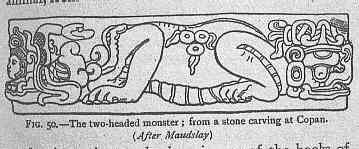

Notice how the mouths of each head are redolent of the highly stylized snake heads in the Ceremonial Bar. The left head also contains an emerging head of a diety image, much as seen in some Ceremonial Bars as well.
The double-headed image appears in a number of Mayan statues, such as the double-headed jaguar that guards the Palace of the Governor at Uxmal on the Yucatan Peninsula, Mexico. There, it aids astronomical alignments with Venus perhaps to synchronize or signal agricultural activities; it also symbolizes natural calamities associated with the Venus symbol that adorns the Palace of the Governor, and works together with a large, adjacent phallic carving at the Palace to also conjure the power and fertility of the earth.
So again, we find that Mayan symbols threaded through science, religion, agriculture, and political rule. How dissimilar, and how much poorer, is our modern culture with its compartmentalizing of such facets of life!
* * *
I was rather startled to find that the double-headed dragon figure had reached far beyond the Meso-American world of the ancient Mayans. The following photograph shows that the double-headed dragon symbol also appears on the Tomb of Esmarelda in Trujillo, Pero (click on the image for a larger picture). Amazingly, this is not a Mayan site, but an ancient Incan site.
The double-headed image above is that of a serpent (dragon), stretching across the top of the largest central panel and down each side, with the gaping mouths of each serpent head pointing downward toward the earth. Further, notice what is within each gaping mouth: a manikin-like humanoid image, probably a god-image much as appears in the Mayan Ceremonial Bar and on some of the Mayan ceremonial staffs!
Why and how the ancient Incans shared such imagery with the ancient Mayans is baffling. One possibility is that an even more ancient culture, the Olmecs of Mesoamerica, spread such symbols far and wide, and were actually the progenitors of much of the symbolism that we now attribute to Mayans.
Back to the Ancient America Page
Back to The Knowledge Plexus